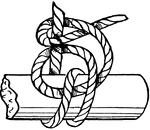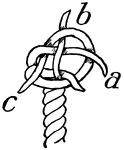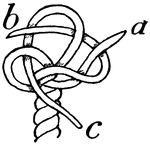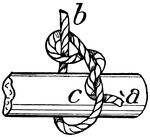Clipart tagged: ‘knot tying’

Blackwall Hitch
To tie a blackwall hitch, form a bight at the end of a rope, and put the hook of a tackle through the…

Carrick Bend
To tie a carrick bend, lay the end of one rope over its own standing part so as to form a bight. Put…

Clove Hitch
To tie a clove hitch, first pass the end 'a' around a spar, and cross it over 'b'. Pass it around the…

Fisherman's Bend
To tie a fisherman's bend, take two turns round a spar, then a half hitch round the standing part, and…

Bowline Knot
To tie a bowline knot, lay the end of the rope 'a' over 'b' so as to form a bight 'c'; pass the end…

Half-Hitch Knot
To form a half-hitch, pass the end 'a' of the rope around the standing part 'b', and through the bight.

Overhand Knot
The most common type of knot, the overhand is made by passing one end of a line over the line and around…

Reef Knot
A reef knot is formed by taking an overhand knot and repeating the overhand knot process (pass one end…

Sheet Bend
To form a sheet bend, pass the end of one rope through the bight of another, round both parts of the…

Single Wall and Crown
To make a crown on a single wall knot, take one of the ends, 'a', and lay it over the knot: lay 'b'…

Single Wall Knot
Unlay the end of a rope, and with the strand 'a', form a bight. Take the next strand 'b' round the end…

Timber Hitch
To tie a timber hitch, take the end 'a' of a rope round a spar, then round the standing part 'b', then…